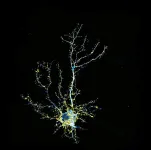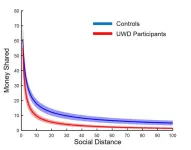(Press-News.org) Philadelphia, April 14, 2024 – Researchers from the Epilepsy Neurogenetics Initiative (ENGIN) at Children’s Hospital of Philadelphia (CHOP) have completed a comprehensive natural history study of SCN8A-related disorders, which represent a spectrum of neurological symptoms. The study, using retrospective clinical information analyzed through novel data analysis methods, revealed a range of seizure types and neurodevelopmental features, and identifies potential targets for future clinical trials. The findings were published online on April 14, 2025, in Neurology®, the medical journal of the American Academy of Neurology.
ENGIN evaluates and cares for children with difficult-to-treat or unexplained epilepsies, genetic epilepsy syndromes and other genetic neurodevelopmental disorders. Variants in certain genes have been linked to epilepsy syndromes and other disorders. Pathogenic variants in the SCN8A gene cause a spectrum of neurological conditions, including epilepsy ranging in severity from mild to severe seizures, developmental delays, autism spectrum disorder, and movement disorders.
SCN8A-related disorders are among the most common genetic epilepsies and treatment of children with these conditions is challenging due to the lack of precision treatments and because the overall history of these conditions across the lifespan is poorly understood. In particular, the time course of clinical symptoms, or phenotypes, associated with these disorders remain largely uncharacterized because of the wide range of variability and limited population sizes previously studied.
“Since the initial discovery in 2012, SCN8A-related disorders have received significant attention given the frequency of the condition and because SCN8A represents a potential therapeutic target,” said senior study author Jillian McKee, MD, PhD, an ENGIN Epileptologist specialized in neurogenetic disorders at CHOP. “However, in order to move toward our goal of launching clinical trials for these patients, an understanding of the natural history of these disorders is critical for developing outcome measures and identifying the key time periods for intervention.”
In this study, researchers utilized electronic medical record data from 82 patients with SCN8A-related disorders and compared that information to a cohort of 2,833 patients with other genetic epilepsies. To help standardize clinical information across electronic medical records, the researchers employed the Human Phenotype Ontology (HPO), a dictionary of more than 15,000 terms to help standardize how clinical information can be analyzed, accelerating the integration of precision medicine into clinical practice.
The study found that patients with SCN8A-related disorders had more than 10-fold risk for developing bilateral tonic-clinic seizures as early as one year old, a fact that was previously not appreciated. Gain-of-function SCN8A variants, which increase the activity of the sodium channel, lead to an increased risk of seizures as early as 6 months old and global developmental delay as early as 3 months old when compared to the broader cohort of SCN8A patients. Patients with loss-of-function variants, on the other hand, were more likely to have atypical absence seizures, which involve instances of “blanking out,” at around four years old.
In later childhood, patients with the recurrent p.Arg1617Gln variant of SCN8A were more likely to have focal seizures, whereas patients with the p.Asn1877Ser variant were more likely to experience generalized-onset seizures. An understanding of these genotype-phenotype correlations will be critical when designing outcome measures and selecting participants for future clinical trials. Additionally, using sodium channel blockers to help manage SCN8A epilepsy was more effective in patients with gain-of-function variants as well as patients whose variants were not yet functionally characterized, suggesting that some of these variants may also be gain-of-function variants.
“Our analysis found that there is a significant developmental burden in SCN8A-related disorders with unique features that set these conditions apart from other epilepsies,” McKee said. “Knowing how unique features of SCN8A-related disorders develop over time is the first step towards readiness for clinical trials, so we can help our patients with these severe conditions.”
This work was supported by the CURE Epilepsy Rare Epilepsy Partnership Award for SCN8A, co-funded by The Cute Syndrome Foundation, the National Institute of Neurological Disorders and Stroke grants R01 NS127830-01A1, R01 NS131512-01 and K02 NS112600, and intramural funds of the Children’s Hospital of Philadelphia through the Epilepsy NeuroGenetics Inititative (ENGIN).
Magielski et al, “Deciphering the natural history of SCN8A-related disorders.” Neurology. Online April 14, 2025. DOI: 10.1212/WNL.0000000000213533
About Children’s Hospital of Philadelphia:
A non-profit, charitable organization, Children’s Hospital of Philadelphia was founded in 1855 as the nation’s first pediatric hospital. Through its long-standing commitment to providing exceptional patient care, training new generations of pediatric healthcare professionals, and pioneering major research initiatives, the hospital has fostered many discoveries that have benefited children worldwide. Its pediatric research program is among the largest in the country. The institution has a well-established history of providing advanced pediatric care close to home through its CHOP Care Network, which includes more than 50 primary care practices, specialty care and surgical centers, urgent care centers, and community hospital alliances throughout Pennsylvania and New Jersey. CHOP also operates the Middleman Family Pavilion and its dedicated pediatric emergency department in King of Prussia, the Behavioral Health and Crisis Center (including a 24/7 Crisis Response Center) and the Center for Advanced Behavioral Healthcare, a mental health outpatient facility. Its unique family-centered care and public service programs have brought Children’s Hospital of Philadelphia recognition as a leading advocate for children and adolescents. For more information, visit https://www.chop.edu.
END
Children’s Hospital of Philadelphia researchers chart natural history of patients with SCN8A-related disorders
Researchers discovered increased incidence of specific seizures both in infancy and later in childhood that could help explain disease trajectory and set important clinical trial targets
2025-04-14
ELSE PRESS RELEASES FROM THIS DATE:
Archaeologists measured and compared the size of 50,000 ancient houses to learn about the history of inequality -- they found that it’s not inevitable
2025-04-14
We’re living in a period where the gap between rich and poor is dramatic, and it’s continuing to widen. But inequality is nothing new. In a new study published in the journal PNAS, researchers compared house size distributions from more than 1,000 sites around the world, covering the last 10,000 years. They found that while inequality is widespread throughout human history, it’s not inevitable, nor is it expressed to the same degree at every place and time.
“This paper is part of ...
Peptide imitation is the sincerest form of plant flattery
2025-04-14
LA JOLLA (April 18, 2025)—Industrial farming practices often deplete the soil of important nutrients and minerals, leaving farmers to rely on artificial fertilizers to support plant growth. In fact, fertilizer use has more than quadrupled since the 1960s, but this comes with serious consequences. Fertilizer production consumes massive amounts of energy, and its use pollutes the water, air, and land.
Plant biologists at the Salk Institute are proposing a new solution to help kick this unsustainable fertilizer habit.
In a new study, the researchers identified ...
Archaeologists discover historical link between inequality and sustainability
2025-04-14
EMBARGOED UNTIL 15.00 US ET (20.00 BST) ON MONDAY 14 APRIL 2025
The study lead by Professor Dan Lawrence, of Durham University in the UK, found that across ten millennia, more unequal distributions of wealth correlated with longer-term human settlement.
However, the team are keen to stress that one factor is not causally dependent on the other, giving hope that humankind’s survival is not linked to ever increasing inequality.
The research is part of a Special Feature of the Proceedings of the National Academy of Sciences (PNAS), entitled Global Dynamics of Wealth Inequality.
Sustainability is defined by the ...
Researchers develop an LSD analogue with potential for treating schizophrenia
2025-04-14
University of California, Davis researchers have developed a new, neuroplasticity-promoting drug closely related to LSD that harnesses the psychedelic’s therapeutic power with reduced hallucinogenic potential.
The research, published in Proceedings of the National Academy of Sciences, highlights the new drug’s potential as a treatment option for conditions like schizophrenia, where psychedelics are not prescribed for safety reasons. The compound also may be useful for treating other neuropsychiatric ...
How does our brain regulate generosity?
2025-04-14
Are there areas of the brain, which regulate prosocial, altruistic behaviour? Together with colleagues from the universities in Lausanne, Utrecht and Cape Town, researchers from Heinrich Heine University Düsseldorf (HHU) have studied a very special group of patients and established that the “basolateral amygdala” (part of the limbic system) plays an important role in this. In the scientific journal Proceedings of the National Academy of Sciences (PNAS), they describe that this region calibrates social behaviour.
Prosocial ...
New study reveals wealth inequality’s deep roots in human prehistory
2025-04-14
PULLMAN, Wash. — Wealth inequality began shaping human societies more than 10,000 years ago, long before the rise of ancient empires or the invention of writing.
That’s according to a new study led by Washington State University archaeologist Tim Kohler that challenges traditional views that disparities in wealth emerged suddenly with large civilizations like Egypt or Mesopotamia. The research is part of a special issue of the Proceedings of the National Academy of Sciences, co-edited by Kohler and Amy Bogaard, an archaeologist at Oxford University in England.
Drawing on data from over 47,000 residential ...
New archaeological database reveals links between housing and inequality in ancient world
2025-04-14
If the archaeological record has been correctly interpreted, stone alignments in Tanzania’s Olduvai Gorge are remnants of shelters built 1.7 million years ago by Homo habilis, an extinct species representing one of the earliest branches of humanity’s family tree.
Archaeological evidence that is unambiguously housing dates to more than 20,000 years ago—a time when large swaths of North America, Europe and Asia were covered in ice and humans had only recently begun living in settlements.
Between that time and the dawn of industrialization, the archaeological record is rich not only with evidence of settled life represented by housing, but also with evidence ...
New, non-toxic synthesis method for “miracle material” MXene
2025-04-14
It is one of the most significant trends in materials science: materials that consist of only a single layer of atoms, so-called “2D materials”, often show completely different properties than thicker layers consisting of the same atoms. This field of research began with the Nobel Prize-winning material graphene. Now, research is being conducted into the material class of MXenes (pronounced Maxenes), which consist mainly of titanium and carbon, by TU Wien (Vienna) together with the companies CEST and AC2T.
These MXenes have properties that ...
Cutting-edge optical genome mapping technology shows promise for diagnosis, prognosis, and therapeutic options of multiple myeloma
2025-04-14
Philadelphia, April 14, 2025 – Researchers have demonstrated the potential of the innovative optical genome mapping (OGM) technique for the diagnosis, prognosis, and therapeutic management of multiple myeloma. This new study in The Journal of Molecular Diagnostics, published by Elsevier, details how this novel method can establish the cytogenomic profile of the tumor on a scale suitable for routine practice in cytogenetics laboratories.
Multiple myeloma, a type of blood cancer that forms in plasma cells (a type of white blood cells), is the second ...
Study looks at impact of COVID-19 pandemic on rates of congenital heart disease procedures among children
2025-04-14
Major reallocation of healthcare services during the COVID-19 pandemic meant that elective surgery in children with congenital heart disease (CHD) was significantly reduced, so that those needing urgent, lifesaving and emergency surgery could be treated. However, this prioritisation of the most severely ill children did not increase overall post-operative complications rates or death, a study led by the University of Bristol has shown.
The research, published in Open Heart, suggests that prioritising surgery for younger and more critically ill children may be appropriate when there is a sudden disruption of usual care. The ...
LAST 30 PRESS RELEASES:
Researchers use robotics to find potential new antibiotic among hundreds of metal complexes
Gut bacteria changes at the earliest stages of inflammatory bowel disease
Scientists develop new way to “listen in” on the brain’s hidden language
Brain research: “Pulse generators” grow and shrink as memories are formed
For teens, any cannabis use may have impact on emotional health, academic performance
School meals could unlock major gains for human and planetary health
Menopause hormone therapy does not appear to impact dementia risk
Signature patterns of brain activity may help predict recovery from traumatic brain injury
Dresden study uncovers new key mechanism in cancer cells
New species are now being discovered faster than ever before, study suggests
Cannabis-based products show limited short-term benefit for chronic pain, with increased risk of adverse effects
Cannabis products with more THC slightly reduce pain but cause more side effects
Clearing the brain of aging cells could aid epilepsy and reduce seizures
Brain injuries linked with potential risk of suicide, new study finds
New technique lights up where drugs go in the body, cell by cell
New study finds movement of fishing fleets can reveal shifts in marine ecosystems
Embargoed: New evidence points to potential treatment for vascular dementia
Study uncovers disrupted brain balance in alcohol dependence
Working in groups can help Republicans and Democrats agree on controversial content moderation online
Structural findings reveal how distinct GPCR ligands create different levels of activation
Anything-goes “anyons” may be at the root of surprising quantum experiments
UC review: Maximizing workplace opportunity for veterans
From generation to complex control: Metasurfaces make perfect vortex beams "within reach"
Thin-film lithium niobate-based detector: recent advances and perspectives
Exploring why some people may tend to persistently make bad choices
How cells balance their protein levels
Nirsevimab vs RSVpreF vaccine for RSV–related hospitalization in newborns
Effectiveness and impact of maternal RSV immunization and nirsevimab on medically attended RSV in US children
AI gives scientists a boost, but at the cost of too many mediocre papers
Next-generation vision model maps tree growth at sub-meter precision
[Press-News.org] Children’s Hospital of Philadelphia researchers chart natural history of patients with SCN8A-related disordersResearchers discovered increased incidence of specific seizures both in infancy and later in childhood that could help explain disease trajectory and set important clinical trial targets




